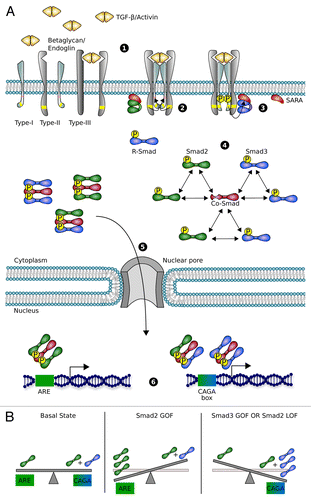Figures & data
Figure 1. Scheme of the TGF-β pathway. (A) (1) Dimers of soluble Activin or TGF-β ligands bind their specific Ser/Thr kinase receptor type II, presented by the co-receptor betaglycan. (2) The complex oligomerizes and phosphorylates receptor type I and finally forms the tetrameric active ligand-receptor complex. (3) This complex phosphorylates R-Smad transcription factors (Smad2 in green and Smad3 in blue), recruited to plasma membrane by the anchor protein SARA. (4) Heterodimers or homodimers of R-Smad bind the Co-Smad (Smad4) to form the transcriptionally active heterotrimers. (5) Smad oligomers are actively transported to the nucleus, where (6) they bind to specific promoter regions and regulate gene expression. Specifically, Smad2-Smad2-Smad4 homotrimer is recruited to ARE while Smad3-Smad3-Smad4 homotrimer and Smad3-Smad2-Smad4 heterotrimer bind to CAGA box in the promoter regions of their target genes. (B) In the basal state Smad2 directed transcription (ARE) is accomplished only by Smad2-Smad2-Smad4 homotrimer while Smad3 targets (CAGA box) are regulated by both Smad3-Smad2-Smad4 and Smad3-Smad3-Smad4 trimers. Increasing the levels of Smad2 (Smad2 GOF) shifts the balance to overexpress Smad2 targets (ARE). Similarly, Smad3 GOF leads to overexpression of Smad3 targets. Depletion of Smad2 protein (Smad2 LOF) contributes not only to downregulate Smad2 targets, but also to increase Smad3 driven transcription.

